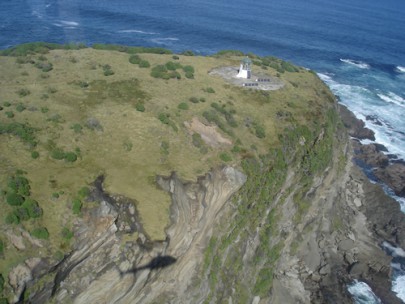Coastal cliffs on quartzose rocks
In this section
-
Coastal
- Active sand dunes
- Basic coastal cliffs
- Calcareous coastal cliffs
- Coastal cliffs on acidic rocks
- Coastal cliffs on quartzose rocks
- Coastal rock stacks
- Coastal turfs
- Dune deflation hollows
- Shell barrier beaches ('Chenier plains')
- Shingle beaches
- Stable sand dunes
- Stony beach ridges
- Ultrabasic sea cliffs

Quartzite cliffs at Puysegur Point, Fiordland (Rowan Buxton)
Coastal cliffs are very steep rock faces near the sea that are greater than 5 m in height. They may ascend in steps and have ledges, crevices and overhangs. Coastal cliffs may rise directly from the sea or be separated from it by a narrow shore. Quartzose is a granular metamorphic rock consisting essentially of quartz and it is extremely infertile. Cliffs and outcrops provide many varied habitats: from bare rock colonised only by mosses and lichens to deeper soils supporting woody vegetation; from highly exposed situations to heavily shaded and sheltered habitats; and from very dry to permanently wet surfaces. Coastal cliffs are influenced by salt spray, particularly near their bases, and halophytes (salt tolerant plants) often characterise these habitats. Some widespread native species include New Zealand ice plant (Disphyma australe), small-leaved pohuehue (Muehlenbeckia complexa), silver tussock (Poa cita), New Zealand spinach (Tetragonia implexicoma) and taupata (Coprosma repens). Floristic richness increases in seepages. Native species that have been lost from neighbouring habitats may find refuge on coastal cliffs.
Synonyms
Quartzite coastal cliffs
Notable flora and fauna
There are no known threatened plants on these cliffs. Formally these sites would once have had large colonies of sea birds such as petrels.
Threat status
Not threatened (Holdaway et al. 2012)
Threats
Erosion can be a threat to coastal cliffs (although it is a natural process) but hard rocks like some quartzites are less frequently undermined by the sea than cliffs composed of softer and more incoherent sandstone or mudstone. Landslides resulting from marine erosion are even more frequent where the rocks are unconsolidated, such as shattered greywacke. The greater openness increases susceptibility to weed invasion. There may be some grazing at the tops of sea cliffs. Near urban centres, coastal cliff tops also are desirable locations for dwellings, and the resulting rubbish dumping, but quartzose cliffs are far from such centres.
Where do they occur?
Quartzite coastal cliffs are found only in the South Island, mainly in Westland and Fiordland.
Further reading
Kennedy DM, Dickson ME 2007. Cliffed coasts of New Zealand: perspectives and future directions. Journal of the Royal Society of New Zealand 37: 41-57.
Wardle P. 1991. Vegetation of New Zealand. Cambridge University Press. Pp. 375-396.


